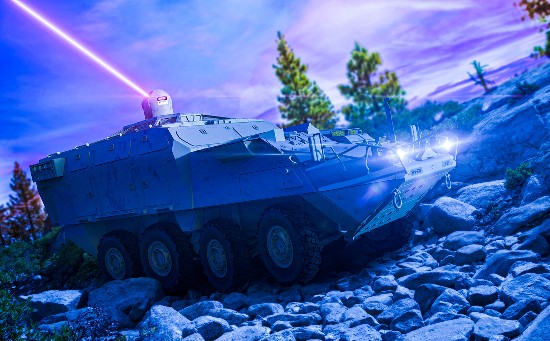The contractor is Lockheed Martin. The project technology goes by the name DEIMOS who in Greek mythology was one of the twins born to Aphrodite from her liaison with Ares, the God of War. Deimos is also one of the two Martian moons, the other is Phobos, Deimos’ twin brother.
In a very Star Trekkian development, Lockheed Martin demonstrated DEIMOS, (Directed Energy Interceptor for Maneuver Short-Range) system. This 50 Kilowatt tactical laser will be mounted on the army’s Stryker combat vehicle for use against enemy drones, helicopters and other aircraft.
One cannot imagine a future when DEIMOS will spawn space-based lasers to make Marjorie Taylor Greene almost sound prophetic except the lasers will be Lockheed Martin and not Jewish.
Speaking of Jewish, Israel recently announced that its Iron Beam laser interception system had shot down a missile fired at the country. The cost per shot was US $3.50. A Patriot missile would have cost $4 million to knock out the enemy attacker.
It is the economics of laser weapon systems that makes this type of ordinance so attractive. At the moment various vendors like Lockheed Martin, and Raytheon are building 50 Kilowatt laser weapons. But there is no determining limit on the strength. The U.S. Department of Defense estimates a 100 Kilowatt laser could easily handle a drone, a small boat, a shell fired by artillery, and even a mortar. For a cruise missile, the estimate is a 300 Kilowatt laser, and for a ballistic missile or hypersonic weapon, a 1 Megawatt laser. Lockheed Martin is already testing a 300 Kilowatt version of DEIMOS.
The US Navy is looking at 100 Kilowatt versions of DEIMOS for its ships and looks like it will replace arming vessels with rail gun technology which now appears to be considered obsolete. Rail guns were high-speed ordinance systems designed to knock down incoming cruise missiles but when costs are compared the laser has the technology beat.
Lockheed Martin’s version performs in any atmospheric condition. Combined with target tracking radar the laser can be pointed at a target with precision even when travelling at hypersonic speeds.
DEIMOS is one of three types of beam weapons being developed by the military. It uses concentrated light to burn a target. The biggest disadvantage of the technology is the narrowness of the beam may damage a weapon by punching a hole in it, but it may not disable it.
DEIMOS has two cousins. The first is the particle-beam weapon which is more akin to what is seen in Star Trek. It can be deployed as a ray gun like the phaser. It can be mounted to serve as a cannon, but instead of shooting shells or cannonballs, it fires a high-energy ion beam. When you think of a particle beam picture the Large Hadron Collider and then shrink it down from 27 kilometres in length to a system as small as a battery on a naval ship or a handgun. When fired a particle-beam weapon emits high-speed streams of subatomic particles with enough kinetic force to damage anything they strike.
The second cousin of DEIMOS is a plasma weapon, one that uses magnets to concentrate ionized gasses and then hurl them at high speed at targets. Powerful magnets today are used in Tokamaks that contain high temperatures and dense plasmas in test fusion reactors.
In all three cases, whether laser, particle or plasma, the width and precision of the beam determine its effectiveness as a weapon.
















